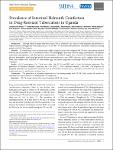| dc.contributor.author | Baluku, Joseph Baruch | |
| dc.contributor.author | Nakazibwe, Bridget | |
| dc.contributor.author | Wasswa, Amir | |
| dc.contributor.author | Naloka, Joshua | |
| dc.contributor.author | Ntambi, Samuel | |
| dc.contributor.author | Waiswa, Damalie | |
| dc.contributor.author | Okwir, Mark | |
| dc.contributor.author | Nabwana, Martin | |
| dc.contributor.author | Bongomin, Felix | |
| dc.contributor.author | Katuramu, Richard | |
| dc.contributor.author | Nuwagira, Edwin | |
| dc.contributor.author | Ntabadde, Kauthrah | |
| dc.contributor.author | Katongole, Paul | |
| dc.contributor.author | Senyimba, Catherine | |
| dc.contributor.author | Andia-Biraro, Irene | |
| dc.date.accessioned | 2023-07-18T09:43:47Z | |
| dc.date.available | 2023-07-18T09:43:47Z | |
| dc.date.issued | 2022 | |
| dc.identifier.citation | Baluku, J. B., Nakazibwe, B., Wasswa, A., Naloka, J., Ntambi, S., Waiswa, D., ... & Andia-Biraro, I. (2022, October). Prevalence of Intestinal Helminth Coinfection in Drug-Resistant Tuberculosis in Uganda. In Open Forum Infectious Diseases (Vol. 9, No. 10, p. ofac541). US: Oxford University Press. | en_US |
| dc.identifier.uri | (https://creativecommons. org/licenses/by-nc-nd/4.0/) | |
| dc.identifier.uri | http://ir.lirauni.ac.ug/xmlui/handle/123456789/739 | |
| dc.description.abstract | Background. Although a third of people with tuberculosis (TB) are estimated to be coinfected with helminths, the prevalence is
largely unknown among people with drug-resistant TB (DR-TB). We determined the prevalence of helminth coinfection among
people with DR-TB in Uganda.
Methods. In a multicenter, cross-sectional study, eligible Ugandan adults with confirmed DR-TB were consecutively enrolled
between July to December 2021 at 4 treatment centers. Sociodemographic data were collected using a questionnaire. Participants
underwent anthropometric and blood pressure measurements, and blood samples were evaluated for random blood glucose,
glycated hemoglobin, nonfasting lipid profile, human immunodeficiency virus (HIV) infection, and a complete blood count.
Fresh stool samples were evaluated for adult worms, eggs, and larvae using direct microscopy after Kato-Katz concentration
techniques.
Results. Of 212 participants, 156 (73.6%) were male, 118 (55.7%) had HIV, and 3 (2.8%) had malaria coinfection. The
prevalence of intestinal helminth coinfection was 4.7% (10/212) (95% confidence interval, 2.6%–8.6%). The frequency of
helminth infections was Ancylostoma duodenale (n=4), Schistosoma mansoni (n=2), Enterobius vermicularis (n=2), Ascaris
lumbricoides (n=1), and Trichuris trichiura (n=1).
Conclusions. The prevalence of helminth coinfection was low among people with DR-TB. More studies are needed to
determine the clinical relevance of helminth/DR-TB coinfection.
Keywords. DR-TB; drug-resistant tuberculosis; helminth; MDR; TB; worms | en_US |
| dc.language.iso | en | en_US |
| dc.publisher | Oxford University Press. | en_US |
| dc.subject | DR-TB | en_US |
| dc.subject | Drug-resistant tuberculosis | en_US |
| dc.subject | Helminth | en_US |
| dc.subject | MDR | en_US |
| dc.subject | TB; worms | en_US |
| dc.title | Prevalence of Intestinal Helminth Coinfection in Drug-Resistant Tuberculosis in Uganda | en_US |
| dc.type | Article | en_US |


